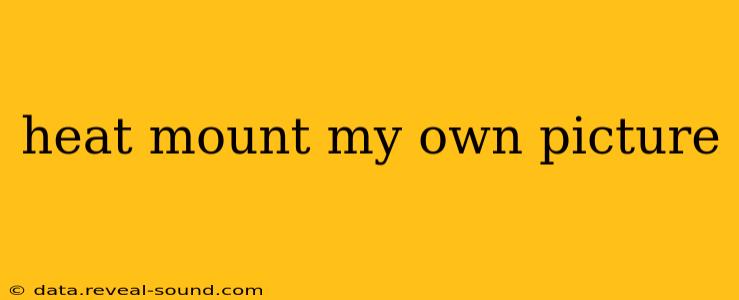Heat mounting, also known as dry mounting, is a fantastic way to preserve and display your cherished photographs. It creates a flat, archival-quality finish that's far superior to simply taping or gluing your prints. This guide will walk you through the process, addressing common questions and concerns.
What is Heat Mounting?
Heat mounting involves using a heat press and special adhesive tissue to bond your photograph to a mounting board. The heat activates the adhesive, creating a permanent, wrinkle-free bond. This method is preferred by archivists and professional photographers for its superior longevity and aesthetic appeal.
What Supplies Do I Need for Heat Mounting?
You'll need a few key items to successfully heat mount your pictures:
- Heat Press: This is the core equipment. Various sizes and models are available, so choose one appropriate for your needs and budget.
- Mounting Board: Choose a board that complements your photograph and provides adequate support. Common choices include foam core, Gator board, and archival mat board.
- Adhesive Tissue: This special tissue contains a heat-activated adhesive. It's crucial to select a type compatible with your photographs and mounting board. Archival-quality adhesive tissue is highly recommended for long-term preservation.
- Heat-Resistant Gloves: Protect your hands from the heat.
- Paper Cutter or Utility Knife: For precise trimming of the mounting board and photograph.
- Ruler: For accurate measurements.
- Protective Cover Sheets: These are placed between the heat press and your photograph to prevent scorching or damage.
What Kind of Adhesive Tissue Should I Use?
The type of adhesive tissue you choose is crucial for the longevity of your mounted print. Look for archival-quality tissue made from acid-free materials. These will help prevent your photograph from degrading over time. Different tissues may be better suited to various print types (e.g., inkjet prints, photographs on different paper types), so read the manufacturer's instructions carefully.
How Do I Prepare My Photograph for Heat Mounting?
Before you begin, ensure your photograph is clean and dry. Any dust or debris can interfere with the bonding process. It’s also a good idea to inspect the photograph for any tears or creases that might be exacerbated by the heat. If possible, address these imperfections before mounting.
What are the Steps Involved in Heat Mounting?
The process generally involves these steps:
- Prepare the Mounting Board: Cut the mounting board to the desired size, ensuring it's slightly larger than your photograph.
- Position the Adhesive Tissue: Carefully center the adhesive tissue on the mounting board, ensuring it's smooth and wrinkle-free.
- Position the Photograph: Carefully position your photograph on top of the adhesive tissue, ensuring it's straight and aligned.
- Use the Heat Press: Gently and evenly apply pressure with the heat press, following the manufacturer's instructions regarding temperature and pressure settings. The heat will activate the adhesive, creating a bond between the photograph and the mounting board.
- Cool Down: Allow the mounted photograph to cool completely before handling.
- Trim (Optional): Once cool, you can trim the edges of the mounting board to achieve a neat, finished look.
What are the Advantages of Heat Mounting?
- Preservation: Provides superior protection against damage, fading, and degradation.
- Flatness: Eliminates wrinkles and creases, resulting in a professional-looking display.
- Longevity: Offers superior archival quality compared to other mounting methods.
- Professional Finish: Creates a clean and polished look.
What are the Disadvantages of Heat Mounting?
- Equipment Cost: Requires a heat press, which can be a significant initial investment.
- Learning Curve: Requires some practice to master the technique.
- Potential for Damage: Improper technique can damage your photographs.
Can I heat mount different types of prints?
Yes, but it's crucial to use the correct type of adhesive tissue for your print type. Inkjet prints, traditional photographic prints, and fine art prints may require different adhesives to prevent damage or discoloration. Always consult the adhesive tissue manufacturer’s instructions.
Is Heat Mounting Difficult?
While it does require some practice and careful attention to detail, heat mounting is a manageable process for anyone with a little patience. Start with smaller prints to develop your technique before tackling larger or more valuable pieces. Remember to always test on a scrap piece of the same material before working on the actual image.
By following this comprehensive guide, you can confidently heat mount your own pictures, preserving your cherished memories for years to come. Remember to prioritize safety and always refer to the manufacturer's instructions for your specific equipment and materials.
